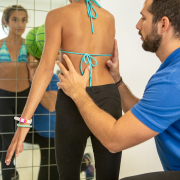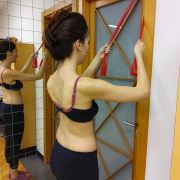Do youngsters with scoliosis walk differently ?
In recent years, many studies have been conducted analysing gait and postural control during walking. Some of these have included gait analysis in youngsters affected by scoliosis.
The first thing to emerge from the literature is that the type of scoliosis does not influence gait. Indeed, no differences in the variables analysed were found between patients with adolescent idiopathic scoliosis and those with congenital scoliosis. Therefore, the gait disturbance in scoliosis is secondary to its existence and not related to its onset or aetiology [1].
In general, study results indicated that patients with scoliosis produced an asymmetrical rotation pattern in the frontal and transverse planes [2] and therefore, when walking, shifted their body to the side and rotated on themselves.
The position of the curve actually influences the motor pattern: in adolescent idiopathic scoliosis, patients with a single thoracic curve showed asymmetrical trunk movement in the transverse plane, whereas those with a single lumbar curve showed asymmetrical trunk movement in the coronal plane. These results suggest that the postural control strategy of patients with scoliosis differs according to the curve pattern [3].
Contrary to what X-rays deceptively show, scoliosis is not solely a deformity in the frontal plane but rather a fully three-dimensional deformity that X-rays can show only in two dimensions. This is confirmed by the findings of several analyses in which postural adjustments during walking were observed in all three space planes [4].
Scoliosis reduces the physiological curves in the sagittal plane, mainly due to loss of dorsal kyphosis. One study has, in fact shown that patients with scoliosis “may lean backwards and have posterior postural sway, which may be associated with hypokyphosis during walking” [5].
It has also been observed that adolescents with scoliosis have difficulty maintaining smooth bodyweight transfers during strides and that this difficulty increases with increasing severity of the spinal deformity. Gait parameters, namely the loading response, midstance phase and propulsion phase, were not found to differ between the left and right sides. However, patients with moderate and severe scoliosis had asymmetrical gait periods in both limbs, suggesting abnormal asymmetrical gait patterns [6].
Given all this information, we were drawn to a recently published meta-analysis in which reduction of the stance phase and restriction of frontal pelvic motion was found to lead to prolonged activation timing of the quadratus lumborum, erector spinae and gluteus medius muscles [7].
A final question was whether these differences in walking might affect youngsters’ daily lives. In this regard, one study, using a pedometer installed on smartphones, showed no difference in daily walking distance between adolescents with and without scoliosis [8].
References
[1] Garg B, Gupta M, Mehta N, Malhotra R. Influence of Etiology and Onset of Deformity on Spatiotemporal, Kinematic, Kinetic, and Electromyography Gait Variables in Patients with Scoliosis-A Prospective, Comparative Study. Spine (Phila Pa 1976). 2021 Mar 15;46(6):374-382. doi: 10.1097/BRS.0000000000003796. PMID: 33620181.
[2] Yang JH, Suh SW, Sung PS, Park WH. Asymmetrical gait in adolescents with idiopathic scoliosis. Eur Spine J. 2013 Nov;22(11):2407-13. doi: 10.1007/s00586-013-2845-y. Epub 2013 Jun 4. PMID: 23732766; PMCID: PMC3886502.
[3] Nishida M, Nagura T, Fujita N, Hosogane N, Tsuji T, Nakamura M, Matsumoto M, Watanabe K. Position of the major curve influences asymmetrical trunk kinematics during gait in adolescent idiopathic scoliosis. Gait Posture. 2017 Jan;51:142-148. doi: 10.1016/j.gaitpost.2016.10.004. Epub 2016 Oct 11. PMID: 27764749.
[4] Wu KW, Wang TM, Hu CC, Hong SW, Lee PA, Lu TW. Postural adjustments in adolescent idiopathic thoracic scoliosis during walking. Gait Posture. 2019 Feb;68:423-429. doi: 10.1016/j.gaitpost.2018.12.024. Epub 2018 Dec 18. PMID: 30594870.
[5] Horng J, Liu XC, Thometz J, Tassone C, Duey-Holtz A. Evaluation of plantar pressures and center of pressure trajectories in Adolescent Idiopathic Scoliosis. Stud Health Technol Inform. 2021 Jun 28;280:131-135. doi: 10.3233/SHTI210451. PMID: 34190074.
[6] Zhu F, Hong Q, Guo X, Wang D, Chen J, Zhu Q, Zhang C, Chen W, Zhang M. A comparison of foot posture and walking performance in patients with mild, moderate, and severe adolescent idiopathic scoliosis. PLoS One. 2021 May 17;16(5):e0251592. doi: 10.1371/journal.pone.0251592. PMID: 33999943; PMCID: PMC8128255.
[7] Kim DS, Park SH, Goh TS, Son SM, Lee JS. A meta-analysis of gait in adolescent idiopathic scoliosis. J Clin Neurosci. 2020 Nov;81:196-200. doi: 10.1016/j.jocn.2020.09.035. Epub 2020 Oct 13. PMID: 33222916.
[8] Gaume M, Pietton R, Vialle R, Chaves C, Langlais T. Is daily walking distance affected in adolescent idiopathic scoliosis? An original prospective study using the pedometer on smartphones. Arch Pediatr. 2020 Aug;27(6):333-337. doi: 10.1016/j.arcped.2020.04.002. Epub 2020 Jun 17. PMID: 32563619.










Leave a Reply
Want to join the discussion?Feel free to contribute!